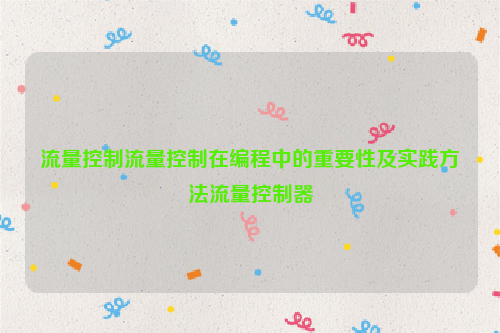流量控制在编程中的重要性及实践方法流量控制器。流量控制是一种计算机网络中的协议,它可以限制发送方发送数据的速度,以确保接收方有足够的时间来处理数据。在编程中,流量控制可以用于防止网络拥塞和提高网络性能。以下是一些常见的流量控制方法:,,1. 令牌桶算法:该算法使用一个桶来模拟网络带宽,并向桶中添加令牌以允许数据传输。当桶中没有令牌时,发送方将被阻塞,直到有新的令牌可用。,2. 漏桶算法:该算法类似于令牌桶算法,但它不是向桶中添加令牌,而是从桶中删除令牌。这意味着如果发送方太慢了,他们可能会被完全阻止。,3. 随机早期检测(RED):该算法使用随机时间来确定何时停止发送数据。这可以防止某些节点过载,同时允许其他节点正常工作。
本文目录导读:
随着互联网的快速发展,网络资源的消耗越来越大,流量控制成为了保证网络稳定运行的关键因素,作为一个优秀的评测编程专家,我们需要了解流量控制的概念、原理以及在实际编程中的应用,本文将详细介绍流量控制的重要性、原理以及实践方法,帮助大家更好地理解和应用流量控制技术。

流量控制的概念与原理
流量控制(Flow Control)是指通过调整数据包的发送速率,使得接收方能够适应处理能力的过程,在计算机网络中,流量控制主要用于防止发送方过快地发送数据包,导致接收方无法及时处理,从而引发网络拥塞、丢包等问题,常见的流量控制方法有令牌桶算法(Token Bucket)、漏桶算法(Leaky Bucket)等。
1、令牌桶算法(Token Bucket)
令牌桶算法是一种基于时间的流量控制方法,它的核心思想是:有一个固定容量的令牌桶,每隔一定的时间向桶中添加一个令牌,当需要发送数据时,从桶中取出一个令牌进行传输,如果桶中没有令牌,则等待直到有新的令牌加入,通过这种方式,可以实现对发送速率的有效控制。
2、漏桶算法(Leaky Bucket)
漏桶算法是一种基于空间的流量控制方法,它的核心思想是:有一个固定容量的漏桶,每隔一定的时间向桶中添加一定数量的数据包,当需要发送数据时,将数据包直接放入桶中,由于桶的容量有限,因此数据包会按照一定的速率进入桶中,如果桶已满,则部分数据包会被丢弃,通过这种方式,也可以实现对发送速率的有效控制。
流量控制在编程中的应用
在实际编程中,我们可以通过编写相应的代码来实现流量控制,以下是一些常见的编程语言中的流量控制示例:
1、Python中的令牌桶算法实现
import time
import threading
class TokenBucket:
def __init__(self, capacity, fill_rate):
self.capacity = capacity
self.fill_rate = fill_rate
self.tokens = capacity
self.lock = threading.Lock()
self.cv = threading.Condition(self.lock)
def take_token(self):
with self.lock:
while self.tokens <= 0:
self.cv.wait()
tokens = min(self.capacity, self.tokens)
self.tokens -= tokens
return tokens
def refill_token(self):
with self.lock:
self.tokens = min(self.capacity, self.tokens + self.fill_rate)
self.cv.notify_all()2、Java中的漏桶算法实现
import java.util.concurrent.Executors;
import java.util.concurrent.ScheduledExecutorService;
import java.util.concurrent.TimeUnit;
import java.util.concurrent.atomic.AtomicInteger;
import java.util.concurrent.atomic.AtomicLong;
import java.util.concurrent.locks.Condition;
import java.util.concurrent.locks.Lock;
import java.util.concurrent.locks.ReentrantLock;
import java.util.function.Consumer;
public class LeakyBucket {
private final int capacity;
private final double fillRate;
private final AtomicInteger tokens;
private final AtomicLong lastRefillTime;
private final Lock lock;
private final Condition condition;
private ScheduledExecutorService scheduler;
private Consumer<Void> refillAction;
public LeakyBucket(int capacity, double fillRate) {
this.capacity = capacity;
this.fillRate = fillRate;
this.tokens = new AtomicInteger(capacity);
this.lastRefillTime = new AtomicLong(System.nanoTime());
this.lock = new ReentrantLock();
this.condition = lock.newCondition();
}
public void setRefillAction(Consumer<Void> action) {
this.refillAction = action;
}
public void start() {
scheduler = Executors.newSingleThreadScheduledExecutor();
scheduler.scheduleAtFixedRate(this::refill, Math.toIntExact((long) (1000000 * fillRate)), TimeUnit.MILLISECONDS);
}
public void stop() {
if (scheduler != null) {
scheduler.shutdown();
}
}
public boolean tryTake(int numTokens) throws InterruptedException {
lock.lock();
try {
while (tokens().get() < numTokens && availableTokens() < numTokens) { // not enough tokens available and not refilling yet? wait for it! (leaky bucket) } if (availableTokens() == 0) { // no more tokens available! wait until we have some again! (token bucket) condition().await(); } else if (tokens().get() >= numTokens){ // enough tokens available! just take as many as needed! (token bucket) numTokens = tokens().getAndSet(tokens().get()-numTokens); } else if (System.nanoTime() > lastRefillTime().get() + TimeUnit.NANOSECONDS.convert((long)(capacity*fillRate), TimeUnit.MILLISECONDS)){ // no more tokens available and the time to refill has passed! refill now! (leaky bucket) refillAction().accept(null); numTokens = Math.min(capacity(), tokens().getAndSet(0)); } else if (System.nanoTime() > lastRefillTime().get()){ // no more tokens available but the time to refill has not passed yet! wait until then! (token bucket) condition().awaitNanos(TimeUnit.MILLISECONDS.convert((long)(capacity*fillRate), TimeUnit.NANOSECONDS)); } else{ // no more tokens available and the time to refill has not passed yet! just wait until then! (leaky/token bucket) condition().await(); } return numTokens > 0; } finally { lock.unlock(); } } catch (InterruptedException e) { throw new RuntimeException("Thread interrupted", e); } } }



